
How to Ride the T-Bar – Beginner Snowboard Tips
In this article titled “How to Ride the T-Bar – Beginner Snowboard Tips”, the author provides helpful tips and tricks for beginners who are looking to conquer the t-bar. The author acknowledges that the t-bar can be intimidating, especially with a line of people watching, but assures readers that by breaking down each step of riding the t-bar and offering a one trick preparation, they can increase their chances of success. Additionally, the article includes a list of common mistakes to avoid in order to stay safe while riding the t-bar.
The article is presented in a conversational tone, with the author addressing readers as “guys” and using casual phrasing like “what’s up.” The instructions are clear and concise, providing specific details on how to approach the loading area, grab the t-bar, and maintain balance while riding. The inclusion of a practice drill for one-footed riding is particularly helpful, as it prepares beginners for the positioning and movements required on the t-bar. Overall, the article aims to equip readers with the necessary knowledge and skills to confidently tackle the t-bar and enjoy their snowboarding experience.

Step 1: Getting Ready
Before you can ride the t-bar, you need to get ready and position yourself correctly. First, skate up to the loading area, making sure to stay in control of your board. Point your board uphill, as the t-bar will be coming from that direction. Look out for the lifty, who will be grabbing the t-bar and guiding it to you. You have the option of grabbing the t-bar behind your front leg or behind your back leg, so decide which position feels more comfortable for you.
Step 2: Mounting the T-Bar
Once the t-bar is in front of you, it’s time to mount it. Grab the t-bar firmly with both hands, making sure to have a secure grip. Place your back foot on the center of your board, ensuring that it is centered and balanced. Shift a bit more weight to your back foot to counter the forward pull of the t-bar. Hold on firmly to the t-bar and keep your back straight with your knees bent. This stance will help you maintain balance and control as you ride the t-bar. It’s also important to keep an eye out for any uneven areas or dips in the snow that may affect your stability.
Step 3: Riding the T-Bar
As you start riding the t-bar, remember to keep your back foot in the center of your board. Push against your back binding to help maintain balance and control. Adjust your weight distribution as the hill gets steeper, leaning more towards the back to counter the steepness and prevent any tipping forward. Stay focused on the terrain ahead of you, watching for any obstacles or changes in the snow that may require adjustments in your position. If you feel the hill is getting too steep, lean back even more to counter it and maintain control.
Step 4: Dismounting the T-Bar
As you approach the end of the t-bar line, it’s time to dismount. Slide the t-bar away from you, following its natural trajectory. Make sure to guide the t-bar in the direction it needs to go, helping it smoothly transition to the next rider. Once the t-bar is clear, turn your board and skate away from the line, giving space for the next person to mount the t-bar.
The One Trick to Prepare for T-Bar
To prepare for riding the t-bar, one important trick to practice is one-footed riding. Find a flat area that is not too busy and start by riding straight with your back foot centered on the board and your weight balanced. This position is similar to how you will be positioned on the t-bar. Practice turning your board from left to right by applying more pressure to your toe or heel edge. Additionally, practice stopping by dragging your toe or heel in the snow. Mastering these one-footed skills will help you feel more confident and prepared for riding the t-bar.
Common Mistakes to Avoid
To ensure a safe and successful ride on the t-bar, it’s important to avoid some common mistakes. One mistake is not being prepared with one-footed riding skills. These skills are crucial for maintaining balance and control while riding the t-bar. Another mistake is grabbing the t-bar in the wrong spot. It’s important to grab it firmly to ensure a secure hold. Losing balance and falling off the t-bar is another common mistake to avoid. This can happen if weight distribution is not adjusted properly or if you are not paying attention to the terrain ahead. When reaching the end of the t-bar line, be sure to slide the t-bar away from you to let it continue smoothly. Finally, losing control while dismounting can lead to accidents, so make sure to turn your board and skate away from the line with control.
Conclusion
Riding the t-bar can be intimidating for beginners, but with proper technique and preparation, it can be a fun and enjoyable experience. By practicing one-footed riding, finding the right grip on the t-bar, maintaining balance and control, and being aware of the terrain ahead, you can have a safe and successful ride. Remember to slide the t-bar away and dismount with control, avoiding common mistakes that can lead to accidents. Stay focused, practice your skills, and enjoy the thrill of riding the t-bar!
